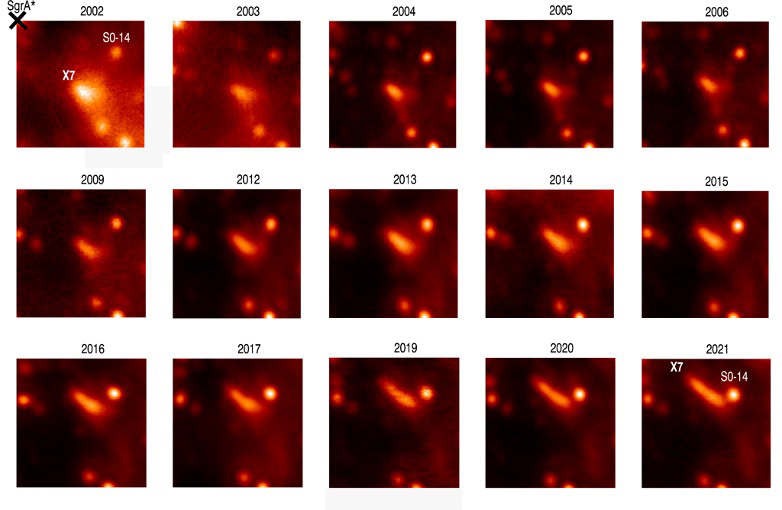Two decades of observations show a dusty gas cloud elongating as it approaches our galaxy’s supermassive black hole.
If you’ve ever wondered what it’s like to fall into a black hole, a dusty gas cloud in the galactic center can give you an idea. Observations of the cloud dating back to 2002 show it’s coming apart in the presence of the supermassive behemoth residing there.
That black hole, called Sgr A*, exerts tidal forces on any objects nearby, pulling harder on the nearer side than on the farther side, and stretching — or spaghettifying — them in the process. The extent of the black hole’s effects depends on the density of the object itself: A cloud will stretch like taffy while a star is less easily torn apart.
Astronomers have picked out one particular cloud, dubbed X7, in images of the galactic center taken over the past two decades. Using the adaptive optics system on the Keck Observatory atop Mauna Kea, Hawai‘i, they’ve watched the cloud move in its orbit. Spectroscopic data, which gives additional information about the cloud’s movements, started in 2006.
By combining these measurements, Anna Ciurlo (University of California, Los Angeles) and colleagues show in the February 20th Astrophysical Journal that X7 is on its way toward the black hole. It will pass within some 3,200 astronomical units (a.u.; 18 light-days) of Sgr A* in 2036. Already, the cloud is stretching out: it’s now nine times as long as it is wide.

A. Ciurlo et al. / UCLA GCOI / W. M. Keck Observatory
The fact that X7 won’t survive its upcoming pass puts a limit on its age. Its orbit is only 170 years long, so the cloud can’t be more than that many years old. Ciurlo’s team therefore suggests that the gas was ejected recently when a pair of stars collided.
That scenario has support in the form of another dusty object, this one known as G3. The so-called G objects are thought to be stars so cocooned in dust that the dust is all we can see. One of these, dubbed G2, survived a pass within just 200 a.u. of Sgr A* in 2014, though not without the loss of some of its dusty shroud. That inward-spiraling material might have been responsible for a series of flares seen from Sgr A* five years later.
G3 is another of these objects, with an orbit surprisingly similar to X7’s. If G3 is the result of a stellar merger, then X7 might represent the dust and gas thrown out during that violent event.
“I agree with Anna and team’s conclusion,” says Stefan Gillessen (Max Planck Institute for Extraterrestrial Physics, Germany), who has studied the galactic center extensively but wasn’t involved in the new study. “It is a very nice work!”
“I am not surprised to see lumps of gas of various sizes in the galactic center,” Gillessen adds. “Actually, this type of gas may well be what is responsible for feeding Sgr A* currently.”
Ultimately, as X7 swings down into the deep of the black hole’s gravitational field, the cloud will come apart. But whether we’ll see the supermassive black hole feed on the 50 Earths’ worth of mass the cloud currently contains remains to be seen. That’s in part because astronomers still aren’t sure how long material takes to flow into the dark maw.
“For sure we will see how X7 is torn apart by the black hole,” Ciurlo says. “After that, who knows? We’ll be watching!”
W. M. Keck Observatory / Adam Makarenko
 3
3









Comments
Yaron Sheffer
March 8, 2023 at 1:00 am
Older readers like me should be able to recall comet Shoemaker-Levy crashing into Jupiter in 1994. It got tidally disrupted into a very elongated train of nuclei while orbiting big ol' Jove, providing an example of spagettification right here in our Solar System!
You must be logged in to post a comment.
Fridtjof Nolte
March 8, 2023 at 7:31 am
I'm curious how the team ruled out a possible perspective effect: in 2002 could they have been viewing an already elongated cloud along its axis causing apparent foreshortening? And by 2021, the cloud had swung around far enough in its orbit so they saw it partially from its longer side? Or do the dimensions and orbital geometry preclude this kind of illusion?
You must be logged in to post a comment.
Monica YoungPost Author
March 8, 2023 at 9:31 am
My understanding is that it's not just the images themselves but the spectroscopy that gives them the necessary data to understand the cloud's dynamics.
You must be logged in to post a comment.
You must be logged in to post a comment.